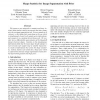CVPR
2007
IEEE
15 years 1 months ago
2007
IEEE
In stereo literature, there is no standard method for evaluating algorithms for semi-dense stereo matching. Moreover, existing evaluations for dense methods require a fixed parame...
CVPR
2007
IEEE
15 years 1 months ago
2007
IEEE
Two major limitations of real-time visual SLAM algorithms are the restricted range of views over which they can operate and their lack of robustness when faced with erratic camera...
CVPR
2007
IEEE
15 years 1 months ago
2007
IEEE
One of the hard problems in automated sign language recognition is the movement epenthesis (me) problem. Movement epenthesis is the gesture movement that bridges two consecutive s...
CVPR
2007
IEEE
15 years 1 months ago
2007
IEEE
This paper proposes a method for precise overlapping of projected images from multiple steerable projectors. When they are controlled simultaneously, two problems are revealed: (1...
CVPR
2007
IEEE
15 years 1 months ago
2007
IEEE
We present a novel model1 for measurement of the arterial pulse from the Superficial Temporal Artery (STA) using passive thermal Infra Red (IR) sensors. The proposed approach has ...
CVPR
2007
IEEE
15 years 1 months ago
2007
IEEE
We present a novel algorithm to jointly capture the motion and the dynamic shape of humans from multiple video streams without using optical markers. Instead of relying on kinemat...
CVPR
2007
IEEE
15 years 1 months ago
2007
IEEE
Calibration techniques for projector-based displays typically require that the display configuration remain fixed, since they are unable to adapt to changes such as the movement o...
CVPR
2007
IEEE
15 years 1 months ago
2007
IEEE
We describe a probabilistic framework for recognizing human activities in monocular video based on simple silhouette observations in this paper. The methodology combines kernel pr...
CVPR
2007
IEEE
15 years 1 months ago
2007
IEEE
We propose a new approach to compute non-linear, intrinsic shape statistics and to incorporate them into a shape prior for an image segmentation task. Given a sample set of contou...
CVPR
2007
IEEE
15 years 1 months ago
2007
IEEE
A good distance metric is crucial for unsupervised learning from high-dimensional data. To learn a metric without any constraint or class label information, most unsupervised metr...

